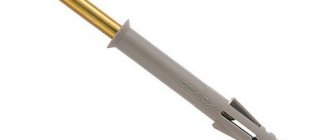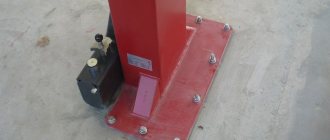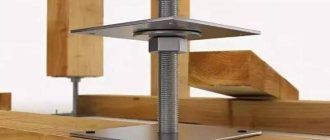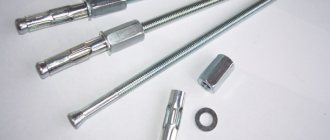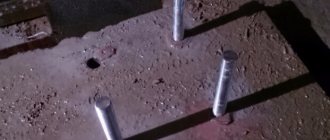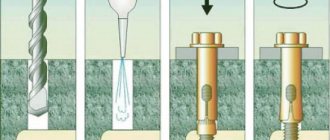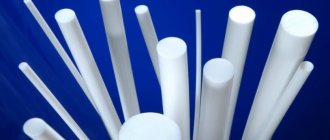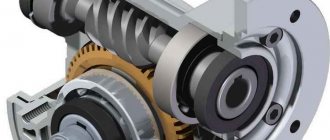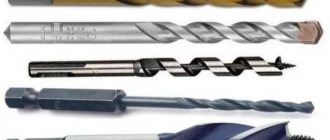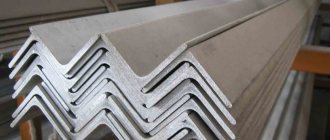Wedge anchor , unlike other types of anchors, has a special feature. It is used only for fastening thin materials or sheets (no more than 5 mm). The material to be fixed must be hard. It is perfect for working with stone, granite or concrete. It is often used when installing suspended ceilings.
Wedge anchor installation technique
- Holes are made in the fastening material and the part to be attached. The size of the holes must match the size of the anchor.
- Clean the finished holes from small stones and dust. Thorough cleaning of the surface is not necessary.
- Place the parts to be fastened so that the holes match.
- Place the wedge anchor into the finished hole and hammer it in so that the plane of the wedge fits completely. Its plane should coincide with the locking cap.
For a reliable fastening that will last a long time, it is necessary to install the fasteners correctly.
Application
It is difficult to dismantle an object secured with a wedge anchor later.
Long anchors of large diameter, up to 20×117, are used in the construction of large structures; they are capable of holding several tens of tons. Simple anchors are used in everyday life. A 6×40 wedge anchor in dense materials – concrete, brick – can withstand loads of up to 300 kg, a 6×60 wedge anchor – up to half a ton. But you need to take into account that the material in which the anchor is installed must be very dense.
Ceiling anchor wedge is used in basic construction for hanging heavy elements from the ceiling, such as strips, channels, sheet metal. Can also be used on walls.
Disadvantages of the wedge anchor:
- It cannot be reused.
- Ceiling fasteners are difficult to dismantle only if you cut off the cap with a grinder or cutter. But usually these fasteners are not used on temporary units.
Technical features
When choosing a mount, you should pay attention to its length and diameter.
| Marking | Anchor and drill diameter, mm | Anchor length, mm | Thickness of the mounted part, mm | Hole depth, mm | Min. anchorage depth, mm | Tightening torque, Nm | Loads (compressed zone of concrete C20/25) | |
| Breakout, kN | Shear, kN | |||||||
| 6x40 | 6 | 40 | 2 | 35 | 25 | 4 | 1,0 | 2,0 |
| 6/15x65 | 6 | 65 | 15 | 45 | 35 | 7 | 1,7 | 2,5 |
| 6/50x100 | 6 | 100 | 50 | 45 | 35 | 7 | 1,7 | 2,5 |
| 8x50 | 8 | 52 | 2 | 45 | 30 | 15 | 3,3 | 3,4 |
| 8/10x72 | 8 | 72 | 10 | 60 | 45 | 15 | 3,6 | 5,7 |
| 8/30x92 | 8 | 92 | 30 | 60 | 45 | 15 | 3,6 | 5,7 |
| 8/50x112 | 8 | 112 | 50 | 60 | 45 | 15 | 3,6 | 5,7 |
| 8/85x147 | 8 | 147 | 85 | 60 | 45 | 15 | 3,6 | 5,7 |
| 10x60 | 10 | 62 | 3 | 50 | 30 | 30 | 3,5 | 3,8 |
| 10/10x92 | 10 | 92 | 10 | 75 | 60 | 35 | 6,3 | 10,3 |
| 10/20x102 | 10 | 102 | 20 | 75 | 60 | 35 | 6,3 | 10,3 |
| 10/30x112 | 10 | 112 | 30 | 75 | 60 | 35 | 6,3 | 10,3 |
| 10/50x132 | 10 | 132 | 50 | 75 | 60 | 35 | 6,3 | 10,3 |
| 10/80x162 | 10 | 162 | 80 | 75 | 60 | 35 | 6,3 | 10,3 |
| 12x85 | 12 | 85 | 3 | 75 | 55 | 50 | 6,5 | 9,6 |
| 12/5x103 | 12 | 103 | 5 | 90 | 70 | 50 | 7,9 | 13,1 |
| 12/20x118 | 12 | 118 | 20 | 90 | 70 | 50 | 7,9 | 13,1 |
| 12/30x128 | 12 | 128 | 30 | 90 | 70 | 50 | 7,9 | 13,1 |
| 12/50x148 | 12 | 148 | 50 | 90 | 70 | 50 | 7,9 | 13,1 |
| 12/65x163 | 12 | 163 | 65 | 90 | 70 | 50 | 7,9 | 13,1 |
| 12/80x178 | 12 | 178 | 80 | 90 | 70 | 50 | 7,9 | 13,1 |
| 12/155x253 | 12 | 253 | 155 | 90 | 70 | 50 | 6,4 | 6,4 |
| 16x90 | 16 | 90 | 3 | 80 | 60 | 100 | 9,9 | 21,8 |
| 16/5x123 | 16 | 123 | 5 | 110 | 85 | 120 | 16,7 | 25,1 |
| 16/20x138 | 16 | 138 | 20 | 110 | 85 | 120 | 16,7 | 25,1 |
| 16/50/168 | 16 | 168 | 50 | 110 | 85 | 120 | 16,7 | 25,1 |
| 16/60x178 | 16 | 178 | 60 | 110 | 85 | 120 | 16,7 | 25,1 |
| 16/95x213 | 16 | 213 | 95 | 110 | 85 | 120 | 10,0 | 10,0 |
| 20/20x170 | 20 | 170 | 20 | 135 | 110 | 240 | 19,8 | 27,7 |
| 20/70x220 | 20 | 220 | 70 | 135 | 110 | 240 | 19,8 | 27,7 |
| 20/130x280 | 20 | 280 | 130 | 135 | 110 | 240 | 19,8 | 27,7 |
The diameter determines the maximum permitted weight that can be hung on the anchor. The heavier the load that needs to be secured, the wider the diameter of the fastener should be. For light loads, a model with a diameter of 6 mm is suitable. For large loads, it is worth using a model with a diameter of 16 mm.
Depending on the thickness of the material being fixed, the length of the anchor varies. To attach a thin plate, you should choose an anchor from 30 mm. For thick sheets, it is better to take fasteners over 100 mm.
Recommendations for selection
When buying a wedge dowel, you need to take into account two parameters of the maximum loads: one is related to alignment, the other represents the maximum value that the bolt can withstand. It is also recommended to check the product certificate . Since dowels are often purchased for the installation of demanding heavy structures, the safety of people depends on their reliability and quality.
The workload can exceed the leveling limit by a maximum of 25%. If the concrete is strong enough, the anchor should be able to withstand high loads.
Analogs
Universal anchor sleeve
Although the bolt does not have a complete analogue in terms of design and functionality, on the construction market you can find a wide range of fasteners that allow you to connect structures made of different types of materials. The following types of parts are widely used in construction work:
- Universal anchor fasteners of standard design.
- Brass anchors , suitable for fixing various building components on concrete surfaces.
- Rod clamps . Their structure requires a large depth, and this must be taken into account when preparing the holes.
- Anchor elements for lightweight materials and structures . They allow you to work with plywood and plasterboard surfaces, securing various lightweight objects to them.
- Chemical fasteners , which use a metal pin and special glue. They are convenient because their installation does not require special physical strength. A capsule is installed in a pre-drilled hole. Inside it are glue and a hardening compound, separated by a partition. Later, a pin is inserted into the hole, which breaks the integrity of the shell and the separation membrane, resulting in the mixing and reaction of the two chemical components. The glue fills the cavity, and after it hardens, a strong bond is formed between the metal fastener and the walls of the hole.
Each fastener is designed for specific loads and connection methods. When selecting fasteners, these factors must be taken into account. The types of materials from which the connecting surfaces are made are also taken into account.
Wedge anchor B
Wedge anchor B
More details
Wedge anchor B
Wedge anchor B Wedge anchor B from the German manufacturer MKT is made by cold forming..
More details
Popular brands and prices
German and Finnish companies are recognized as the best in this area.
- Fischer is a German manufacturer. It produces all possible types of anchor bolts in a wide variety of modifications: with an enlarged washer, with a countersunk head, with a special sleeve design, and so on. Manufacturing of wedge anchors - from galvanized steel and stainless steel, packaging - from 4 to 50 pcs. The cost depends on the size and material of the wedge anchor: for example, the price of a stud anchor with an enlarged washer ranges from 44 rubles. per package up to 1262 RUR per 1 piece.
- Mungo is a Swiss company. Manufactures fastenings from structural and stainless steel, as well as from non-ferrous metals. Packaging includes from 25 to 100 pcs. The cost depends on the size and material - from 780 to 4607 per package.
- Sormat is a Finnish company that has, among other things, developed a design with 2 spacer bushings. Wedge-type anchors from Sormat are produced from electro-galvanized, hot-dip galvanized, stainless and even acid-resistant steel. The cost of products made from hot-dip galvanized steel is more affordable: from 26 to 408 rubles. per piece
- Tox is another German manufacturer that offers galvanized steel fasteners. The products are offered in small packaging - 2-5 pieces, cost - from 190 to 560 rubles.
- Hilti wedge-type anchors are also popular.
The wedge anchor is perhaps the most popular type of such fastener. The reason is its high strength, simplicity and, of course, relatively affordable cost.
The video below will tell you about installing a wedge anchor using SPIT FIX II as an example:
Wedge anchor B A4 (Stainless steel version)
Wedge anchor B A4 (Stainless steel version)
More details
Wedge anchor B A4 (Stainless steel version)
WEDGE Anchor B A4 (STAINLESS VERSION) Wedge anchor B A4 is made of austenitic stainless steel..
More details
Design characteristics
The wedge anchor is a carbon steel pin. There is a thread at one end of the pin, and a wedging mechanism at the other. It is represented by a special coupling, which, when expanded, allows the fastener to be maximally fixed in the base. Unlike similar anchor mechanisms, the wedge type of fastener does not have a protective “jacket”.
This design allows you not to monitor the drilling depth, which is sometimes completely impossible to do.
The wedge anchor consists of several interconnected parts
When installing heavy objects, the pressure that will act on the fastening element is always calculated. This is necessary in order to calculate the size and number of anchors for reliable fixation. All calculations are performed only using a special table by a person who has the necessary experience. Here it is worth considering the fact that the wedge anchor in most cases is taken a little more.
The size of the product is always stamped on the sleeve. To better understand that this is a wedge anchor and not a driven one, for example, the design is marked WAM. If there is no marking, then the diameter can be easily measured with a caliper. For example, let’s imagine the marking of a 15*12*100 anchor for concrete:
- 15 is an indicator of the body diameter. Judging by this criterion, a drill of the appropriate size is selected;
- 12 – stud size, which the wrench used must correspond to;
- 100 is the length of the anchor itself, which is selected depending on the thickness of the wall.
Wedge anchor B fvz
Wedge anchor B fvz
More details
Wedge anchor B fvz
WEDGE ANCHOR B FVZ Wedge anchor B FVZ is the optimal fastening element option for internal..
More details
The company's website presents all types of wedge anchors with their detailed descriptions. Ordering goods is very simple. All you need to do is fill out an application in your personal account or call the phone number listed on the website. Company managers will advise on all issues of interest.
Driven - for fixing communications
Installation of such products is carried out using the driving method. These are ordinary dowels, only they are made not of plastic, but of high-carbon steel. In appearance, it is a seamless metal sleeve with a conical inner surface and longitudinal slits.
The anchor is driven into a pre-prepared hole with a hammer; during installation, the petals form support arms that have a high load-bearing capacity. After this, a bolt of a suitable diameter is screwed into the anchor, which passes through.
Such anchors are used for installing formwork, cable ducts and utilities, gratings, splinker and ventilation systems, and when installing pipelines.
| Advantages | Flaws |
|
|
Products in this group are conventionally divided into 2 categories: ordinary and special. The second group includes products of the “Zikon” series, which are highly expensive and require special tools for installation.
| Manufacturer | Type | Available thread diameters, mm | Examples and explanations of designations (dimensions in mm) | Peculiarities |
| Fischer (Germany) | E.A. | 6, 8, 10, 12, 16, 20 | EA M 8 8 – M 8 internal thread diameter EA SM 10 | Fischer Einschlanganker Steel 1.4401/1/4571, galvanized yellow-passivated or stainless steel A4 |
| EAS | 6, 8, 10 | Lightweight version of the EA anchor made of sheet steel, with collar | ||
| Hilti | HKD-S | 6, 8, 10, 12, 16, 20 | HKD-S M12/50 12 – M 12 internal thread diameter 50 – anchor length. | Flush Anchor Steel strength class 5.8. |
| HDI | Drop-in Anchor | |||
| Mungo | ESA | 6, 8, 10, 12, 16, 20 | ESA M 8 8 – M 8 thread diameter; | Einschlanganker Galvanized steel, yellow-passivated or stainless steel A4 |
| Sormat (Finland) | LA, LAH | 6, 8, 10, 12, 16, 20 | LA 12 12 – M 12 internal thread diameter. | Ly ö ntiankkuri LA – structural steel, electro-galvanized LAH – made of stainless acid-resistant steel A4. |
| Tox (Germany) | T.E. | 6, 8, 10, 12, 16, 20 | TE M16x65 16 – M 16 internal thread diameter. | Einschlaganker Galvanized steel, yellow passivated. |
| NOBEX (Italy) | DROP | 6, 8, 10, 12, 16 | DROP 12×50 [INOX] 12 – M 12 internal thread diameter 50 – anchor length. | |
| Koelner (Poland) | ST | 6, 8, 10, 12, 16, 20 | ST-08 08 – M 8 internal thread diameter. | Drop in anhor Galvanized steel, yellow passivated. |
| Wkret-met (Poland) | T.S.W. | 6, 8, 10, 12, 16 | TSW 10 10 – M 10 internal thread diameter. | Galvanized steel, yellow passivated. |
| Technox (Poland) | TSR | 5, 6, 8, 10, 12, 16 | TSR 8x30 | Tuleja stalova. Galvanized steel |
| Anchor Fasteners (Taiwan) | DRM | 6, 8, 10, 12, 16, 20 | DRM-12 | Drop in anhor Galvanized steel, yellow passivated. |
| INKA (Türkiye) | IDCA | 6, 8, 10, 12, 16 | IDCA08 | Çakmali Dubel |
